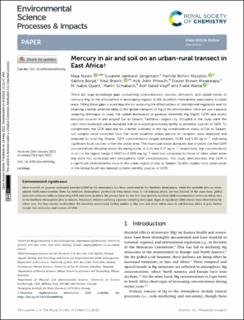| dc.contributor.author | Nipen, Maja | |
| dc.contributor.author | Jørgensen, Susanne Jøntvedt | |
| dc.contributor.author | Bohlin-Nizzetto, Pernilla | |
| dc.contributor.author | Borgå, Katrine | |
| dc.contributor.author | Breivik, Knut | |
| dc.contributor.author | Mmochi, Aviti J | |
| dc.contributor.author | Mwakalapa, Eliezer | |
| dc.contributor.author | Quant, M. Isabel | |
| dc.contributor.author | Schlabach, Martin | |
| dc.contributor.author | Vogt, Rolf David | |
| dc.contributor.author | Wania, Frank | |
| dc.date.accessioned | 2022-07-04T09:09:36Z | |
| dc.date.available | 2022-07-04T09:09:36Z | |
| dc.date.created | 2022-06-03T11:55:31Z | |
| dc.date.issued | 2022 | |
| dc.identifier.citation | Environmental Science: Processes & Impacts. 2022, | en_US |
| dc.identifier.issn | 2050-7887 | |
| dc.identifier.uri | https://hdl.handle.net/11250/3002541 | |
| dc.description.abstract | There are large knowledge gaps concerning concentrations, sources, emissions, and spatial trends of mercury (Hg) in the atmosphere in developing regions of the Southern Hemisphere, particularly in urban areas. Filling these gaps is a prerequisite for assessing the effectiveness of international regulation and for enabling a better understanding of the global transport of Hg in the environment. Here we use a passive sampling technique to study the spatial distribution of gaseous elemental Hg (Hg(0), GEM) and assess emission sources in and around Dar es Salaam, Tanzania's largest city. Included in the study were the city's main municipal waste dumpsite and an e-waste processing facility as potential sources of GEM. To complement the GEM data and for a better overview of the Hg contamination status of Dar es Salaam, soil samples were collected from the same locations where passive air samplers were deployed and analysed for total Hg. Overall, GEM concentrations ranged between <0.86 and 5.34 ng m−3, indicating significant local sources within the urban area. The municipal waste dumpsite and e-waste site had GEM concentrations elevated above the background, at 2.41 and 1.77 ng m−3, respectively. Hg concentrations in soil in the region (range 0.0067 to 0.098 mg kg−1) were low compared to those of other urban areas and were not correlated with atmospheric GEM concentrations. This study demonstrates that GEM is a significant environmental issue in the urban region of Dar es Salaam. Further studies from urban areas in the Global South are needed to better identify sources of GEM. | en_US |
| dc.description.abstract | Mercury in air and soil on an urban-rural transect in East Africa | en_US |
| dc.language.iso | eng | en_US |
| dc.rights | Navngivelse 4.0 Internasjonal | * |
| dc.rights.uri | http://creativecommons.org/licenses/by/4.0/deed.no | * |
| dc.title | Mercury in air and soil on an urban-rural transect in East Africa | en_US |
| dc.title.alternative | Mercury in air and soil on an urban-rural transect in East Africa | en_US |
| dc.type | Peer reviewed | en_US |
| dc.type | Journal article | en_US |
| dc.description.version | publishedVersion | en_US |
| dc.source.pagenumber | 921-931 | en_US |
| dc.source.volume | 24 | en_US |
| dc.source.journal | Environmental Science: Processes & Impacts | en_US |
| dc.identifier.doi | 10.1039/D2EM00040G | |
| dc.identifier.cristin | 2029337 | |
| cristin.ispublished | true | |
| cristin.fulltext | original | |
| cristin.qualitycode | 1 | |

